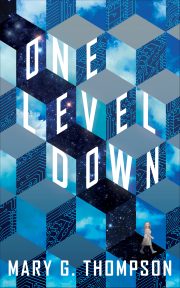Special Synopsis Sauce
by Curtis C. Chen
 So you’ve completed a novel. First of all, congrats–that’s a huge achievement!
So you’ve completed a novel. First of all, congrats–that’s a huge achievement!
You have created story out of nothing. You’ve written and rewritten, weaving together plots and characters for maximum effect. You’ve dedicated months or years to crafting this manuscript–a modern masterpiece that you hope will make ’em laugh, make ’em cry, and make ’em kiss the full hardcover retail price good-bye.
Okay. You wrote a novel. That was the easy part.
Now you need to write a synopsis.
It’s intimidating, I know. I’ve been there. Given all the effort you put into your novel, how do you now strip away most of it in an attempt to sell it? Where do you even start? How do you decide what to cut, what to keep, what to explain? And how do you convey all that information in fewer than a thousand words–i.e., reducing your magnum opus by 99%?
My advice is encapsulated in that one word: reducing. I’m going to present this as a cooking analogy. You’re done making the meal; now it’s time to make the sauce. Allez cuisine!
(DISCLAIMER: I am not a professional chef. Thanks to my wife, who is an excellent cook, for sanity-checking this article. Any errors or deficiencies are mine alone.)
In cooking, reducing a sauce means using heat to remove water from a liquid like broth or wine. This produces a thicker substance which concentrates the flavors of the original liquid.
In writing, reducing your novel to a synopsis does not mean “being reductive” in the pejorative, philosophical sense. The goal is to distill your novel down to its tastiest fundamentals. You can discard certain details without sacrificing crucial information, and enticing a reader with the scent of your story is the best way to get their mouth watering for the whole thing.
So how do you write a synopsis? This is just one method, but here’s my personal recipe:
#
Story Sauce Reduction
(makes one serving of Synopsis)
- Remove chunks.
In cooking, the first step would be to remove meat and other large solids from your liquid, which may include pan drippings. You may also add more liquid before you begin, to get the right balance of flavors which will intensify during the reduction process.
In writing, you’ll have to leave sub- and side-plots and minor characters out of the synopsis. Focus on the primary thread of the story–what is the main conflict? Who is directly involved in that conflict? Nothing else matters for this particular document. Also note that you won’t simply be cutting and pasting bits of your actual manuscript; you’ll use new words to connect the most important ideas together.
One more thing: be careful about including lots of different character names. I recommend only naming three people (protagonist, antagonist, and relationship character) and using titles (e.g., “her mother”) for everyone else you need to mention. Don’t overwhelm your audience with too many flavors.
- Wider is better.
In cooking, more surface area speeds the process of evaporation. Large sauté or braising pans are ideal. Note that you want wide vessels, but not deep ones.
In writing, the synopsis needs to lay out the entire story, which means you can’t “drill down” very much. You’re going for breadth, not depth. This is not the actual meat of the story–it’s just the flavor of it. But make sure all the essential flavors get included.
- Do not cover!
In cooking, leaving your pan uncovered helps evaporation, which is the goal–you want to remove the tasteless water and leave the heavier, flavorful compounds behind.
In writing, don’t cover up any important plot twists or other details in your synopsis. You must include the ending. You must explain exactly how conflicts are resolved. Avoid passive verbs or vague descriptions; clearly identify who’s doing what, and why it matters to the story.
- Wait for it…
In cooking, reducing takes time. After bringing your starting liquid to a boil, you’ll want to simmer it, going “low and slow”: keep the heat high enough to produce movement, but not so high that it causes full bubbling. A full boil will agitate heavier compounds out with the escaping water vapor, and you want to keep that flavor in the sauce.
In writing, it will take time to rewrite your synopsis until it works. Just like the novel itself, you won’t get everything right on the first draft. Ask trusted beta readers to look over your synopsis and see if it’s giving them a clear sense of the actual novel. Use their feedback to identify and fix any confusing or misleading sections.
- Last but not least, ADD BUTTER.
In cooking, once the reduction reaches the desired consistency, you can finish it with some butter. This magical substance will add a little extra thickness and a camera-ready, glossy sheen to your delicious creation.
In writing, once your synopsis is information-complete, consider polishing it to put the “voice” of the novel front and center. The synopsis itself should be in third person and present tense (e.g., “she brews the potion”), but you can choose words and craft sentences to convey the tone of the actual novel (e.g., “she reluctantly brews the deadly potion”).
#
As with all recipes, you’ll want to modify this procedure to suit your own tastes. Experiment and find the particular process that suits you! Every writer is different, and what works for one person may not be the best way for another.
Here are a few more online resources to help with your synopsis:
- “6 Steps for Writing a Book Synopsis” by author Marissa Meyer
- “How To Write A Book Synopsis” by literary agent Carly Watters
- “Back to Basics: Writing a Novel Synopsis” by publishing maven Jane Friedman
That ought to be enough to get you started. Good luck–or, as the French say: bonne chance!
You can find Curtis at Puzzled Pint Portland on the second Tuesday of every month. Visit him online at: http://curtiscchen.com.


